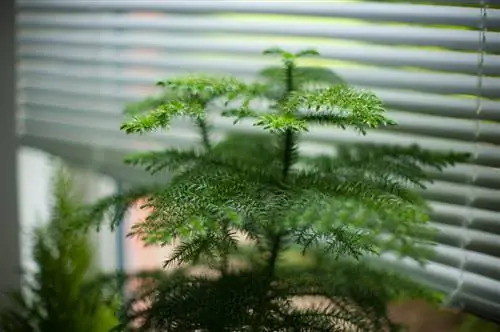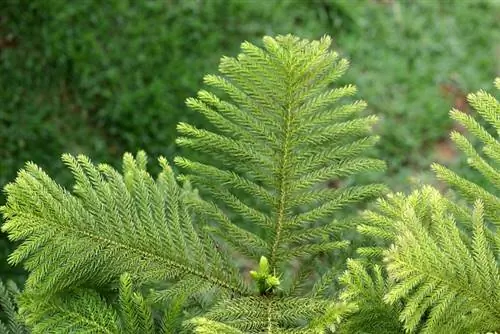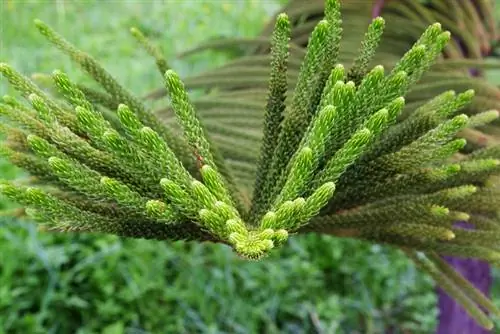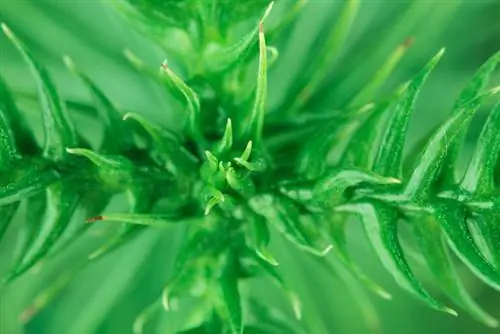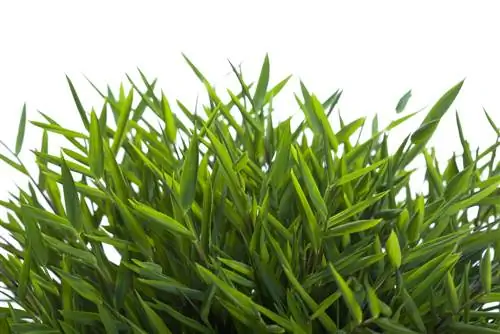- Author admin [email protected].
- Public 2023-12-16 16:46.
- Last modified 2025-01-23 11:22.
Read a commented profile about the indoor fir here with information on growth per year. Lots of tips about successful propagation and proper care.
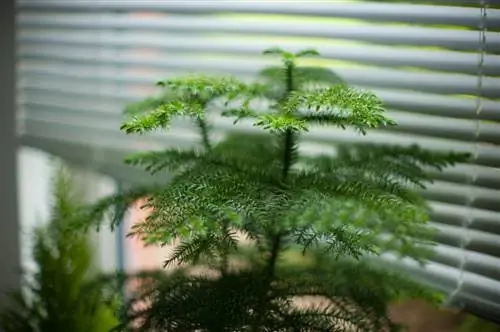
What are the care conditions for an indoor fir?
The indoor fir (Araucaria heterophylla) is an evergreen coniferous plant that is grown as a houseplant. It prefers bright to partially shaded locations at 18-20°C, loose, humus-rich soil and 5-10°C when overwintering. Growth per year is 10-15 cm. Water regularly, fertilize and repot every 2-3 years.
Profile
- Scientific name: Araucaria heterophylla
- Family: Araucaria family (Araucariaceae)
- Synonyms: Norfolk fir, araucaria
- Origin: Norfolk Island
- Growth type: evergreen conifer
- Growth: conical, spreading
- Leaves: Needles
- Flowers: Cones
- Flowering period: April to May
- Toxicity: non-toxic
- Winter hardiness: sensitive to frost
- Use: living space greenery, winter garden, summer balcony
Growth
The indoor fir is a popular pot plant worldwide because it grows strictly symmetrically. In its youth, the Araucaria heterophylla forms a silhouette, as if drawn with a ruler. The following characteristics characterize the growth of an araucaria as a houseplant:
- Growth habit: tightly upright trunk with pyramidal crown
- Special feature: tiers of horizontal side branches with whorled, frond-like twigs
- Growth height at natural location: 50 m to 65 m
- Growth height in indoor cultivation: 1.20 m to 2.20 m
- Growth per year: 10 cm to 15 cm
Depending on local site conditions, the appearance changes over the years. The initially horizontal to slightly hanging branches on the horizontal side branches gradually become vertical.
Video: Admire Araucaria carpenter fir in its natural location
Winter hardiness
The second name Norfolk fir indicates its origin. The home of the carpenter fir is the low altitudes of Norfolk Island in the Pacific Ocean. This natural treasure was discovered here by the legendary seafarer James Cook on his first circumnavigation of the world (1768 to 1771). The island with a subtropical climate lies between Australia and New Zealand. It is frost-free all year round with an average annual temperature of a mild 19° Celsius and high humidity. For this reason, araucaria is not hardy in our latitudes.
leaves
As an evergreen conifer, the indoor fir is a conifer and is distantly related to European firs, spruces and pine trees. In contrast to native coniferous trees, an araucaria impresses with the multifaceted and decorative growth of its leaves. The botanical part of the name heterophylla stands for 'various-leaved', which underlines these properties:
- Leaves on young shoots: fresh green, soft, needle-shaped, curved, 8 mm to 12 mm long
- Leaves on older shoots: bright dark green, scale-shaped, sickle-shaped, 4 mm to 5 mm short
- Leaves in the cone area: broad, egg-shaped, overlapping needles, 6 mm long and 4 mm wide
Planting indoor fir
The indoor fir is rarely available in stores because purchasing sources are few and far between. Anyone who finds what they are looking for in a garden center, online shop or on Amazon will have to dig deep into their pockets. You have to pay 25 to 30 euros for a 60 centimeter small specimen. You can avoid high purchase prices and time-consuming searches by propagating an araucaria. Read on, because in the following sections you will learn important tips on the correct procedure:
Propagate
The best way to propagate an indoor fir is through top cuttings. In the heated indoor greenhouse you can create the high temperatures that are important for rapid rooting. The following short instructions explain the correct procedure:
- Best time is in winter.
- Fill 8 cm pots with coconut soil or growing substrate.
- Cut half-woody shoot tips as cuttings with a complete branch whorl.
- Place the scissors 4 cm below the branch whorl, clean the cut from resin and dip in charcoal powder.
- Plant cuttings so deep that the branch node is above the ground.
- Water the substrate and spray the cuttings with low-lime, room temperature water.
- Let it root in the indoor greenhouse at 18° to 20°.
- Keep the growing substrate slightly moist and spray the cuttings several times a week.
- Extra tip: tie up the top cuttings to save space.
With consistent growing temperatures and high humidity, rooting takes two to three months. Place the mini greenhouse in a bright place without direct sunlight. The cuttings are not initially fertilized. Two weeks after the first repotting, apply a liquid conifer fertilizer at half concentration.
Plant in a pot
For young plants with a complete root ball and a height of around 50 centimeters, the seriousness of life as a container plant begins. You should also repot a purchased araucaria. Use a pot with a bottom opening and 1.5 times the volume of the root ball. Araucaria prefer a slightly acidic, loose, humus-rich soil. As a substrate, we recommend a mixture of peat-free rhododendron soil, coconut fibers and expanded clay. How to plant an indoor fir correctly:
- Cover the bottom of the vessel with a layer of expanded clay balls or clay shards to prevent waterlogging.
- If at hand, cover the drainage with an air and water permeable fleece.
- Fill in the recommended substrate up to a third of the height of the pot and form a hollow.
- Unpot the indoor fir, plant it, press down the soil and water thoroughly.
Location
Araucaria heterophylla thrive best with all-round exposure. If the light varies, your indoor fir tree will grow crooked. The pretty conifer will be happy to keep you company on your balcony and terrace during the nice season. All important location conditions at a glance:
- All year round: bright to semi-shady location at a pleasant 18° to 20° Celsius.
- Ideally from spring to autumn outside in a light-flooded location without direct sun.
- In winter behind glass, bright and frost-free at 5° to 10° Celsius (€6.00 at Amazon).
Outdoors, the Norfolk fir wants a place protected from the rain. Frequent rain showers cause the branches to droop and symmetrical growth is lost.
Excursus
Indoor fir as an extravagant Christmas tree
Did you know? In subtropical countries, Christmas presents traditionally take place under a fir tree. Araucaria thrives with family-friendly, soft needles and an elegant, symmetrical silhouette. Blue spruce and Nordmann fir have to clear the field in January. The Norfolk fir, on the other hand, is useful as a representative houseplant all year round.
Care for indoor fir trees
When it comes to caring for an indoor fir, the bar is a little higher than you know it from other houseplants. Please give the following tips your gardening attention for an araucaria in top form:
Pouring
Your Norfolk fir would prefer to be watered with low-lime water. For this purpose, it is best to use collected rainwater or stale tap water. From spring to autumn, keep the substrate constantly slightly moist. The indoor fir responds to waterlogging or drought stress by shedding its needles.
Fertilize
An indoor fir is fertilized with a liquid conifer or rhododendron fertilizer. It contains all the important nutrients in a lime-free N-P-K formulation. Add the liquid fertilizer to the irrigation water every two weeks according to the manufacturer's instructions. Over-fertilization causes unnatural length growth and limp branches. In the winter months, please stop supplying nutrients.
Repotting
Every two to three years it becomes too tight for the roots in the pot. The space problem can be recognized when the first root strands grow out of the opening in the ground. Now you should repot the indoor fir into a larger container with fresh rhododendron soil. The pot size is chosen correctly if two to three fingers fit between the root ball and the edge of the container. The best time is in spring, shortly before the start of the new growth phase.
Wintering
The delicate nature of wintering for indoor firs has been discussed several times. The following overview summarizes all important care aspects. How to properly overwinter a Norfolk fir:
- Put away at the end of September/beginning of October.
- Ideally hibernate bright and cool at 5° to 10° Celsius (€6.00 at Amazon).
- Water sparingly, spray less often.
A cold winter garden, the unheated, glazed terrace, the bright staircase and a garden house with a frost monitor are well suited as winter quarters. On the other hand, if you overwinter an indoor fir in a cozy, warm living room, the result will be sad, drooping branches and brown needles.
Cutting
In the right location, the indoor fir naturally develops a geometric, sleek appearance with densely needled, frond-like branches. Regular pruning care is not necessary. You can cut back excessively long branches. As with all conifers, the cutting is strictly limited to the green, needle-covered shoot area.
Solve problems
Pests and care errors cause various damage to your indoor fir tree. The following table provides a compact overview and tips for solving problems:
| malicious image | Cause | Countermeasure |
|---|---|---|
| hanging branches | too dark, warm location | Change location |
| brown needles | Air dryness | spray with low-lime water |
| yellow needles | Nutrient Deficiency | Administer rhododendron fertilizer every 14 days |
| brown lace | branches hit obstacle | Push the pot away from the window/wall |
| Needles fall off | Waterlogging | repot, water sparingly from now on |
| white threads, black spots | Mealybugs | spray with soft soap solution |
Popular varieties
The most beautiful indoor fir varieties were created as random seedlings:
- Virgata: well-known, historical variety discovered in a Palermo garden in 1906.
- Compacta: lives up to its variety name with a densely branched, stocky appearance.
- Glauca: Araucaria indoor fir from New Guinea with blue-green needles up to 15 mm long.
- Gracilis: delicate araucaria that reaches a height of 30 centimeters after 10 years.
- Silver Star: decorative, silvery-spotted shoots of the later bright green, soft needles.
FAQ
Is the indoor fir poisonous to cats?
No, the indoor fir contains no toxic ingredients. In fact, the Norfolk fir with its soft needles is one of the family-friendly houseplants for households with children and pets.
My indoor fir tree in the living room leaves the branches hanging. What to do?
If an indoor fir gets too warm, long, thin horny shoots form. These branches hang limply because they lack the strength to align accurately and horizontally. The solution to the problem is a change of location in conjunction with pruning. Place your Norfolk fir in a bright spot with temperatures around 18° Celsius during the season and 5° to 10° Celsius in the winter. The drooping branches will not recover. Cut back affected shoots accordingly. It is important to note that you only cut the conifer in the green needled area.
Is the indoor fir suitable for bonsai?
The New Guinea indoor fir (Araucaria cunninghamii) is more suitable for cultivation as a bonsai than a Norfolk fir. In order to achieve the characteristic growth form, branches, twigs and roots are regularly cut back. This happens every eight weeks between May and September. Wiring the trunk and crown is another method of influencing the desired growth habit.

